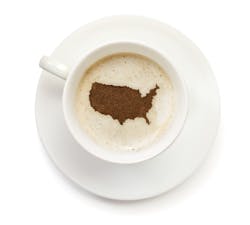It's not unusual for local economies, weather and business openings (or closings) to affect office coffee service revenues. To more closely examine these local differences, especially as they relate to raising prices and the cost per cup of coffee, we took our most recent survey data and split it into six regions. Each region does have a statistically smaller sample size than the State of the Office Coffee Service National Report, but it also uncovers trends unique to each area.
The Northeast
In the U.S., OCS providers in the Northeast felt the need to raise prices. A majority, 72.7 percent, indicated they increased the price for the products and services they provide. The average price per cup for traditional OCS, including frac pack served in plumbed-in or pour-over brewers was reported as 4.33 cents, the lowest price compared to all other regions. For single-cup, the price was reported as 29.7 cents.
Pantry service or direct delivery service (food/snacks/beverages delivered to locations) as well as offering janitorial and office supplies were reported by Northeast OCS providers as the fastest growing segments, followed by traditional, non single-cup coffee.
The Mid-Atlantic
Moving down the coast, OCS providers in the Mid-Atlantic area were equally split on raising prices or keeping prices the same. Of course, according to their responses, the average price received for a cup of traditionally brewed coffee was 11 cents, much higher than the Northeast reports. For single-cup, the price was around 33 cents per cup.
Water service was the fastest growing area, according to Mid-Atlantic respondents. Following in nearly a tie for second was pantry service and the addition of janitorial and office supplies.
The Southeast
OCS providers in the Southeast part of the U.S. reported the least amount of revenue increases, despite almost universally increasing prices. Nearly 85 percent said they raised prices in the end of 2015 and beginning of 2016. The average price for a traditional cup of coffee was listed as 12.6 cents. For single-cup, the price was quite a bit higher at 59 cents per cup.
Offering janitorial and office supplies was the fastest growing segment for Southeast OCS providers, followed by pantry service and tea.
The Midwest
In America’s heartland, about a third of OCS providers raised prices, just 37.5 percent. The vast majority reported no change in their coffee prices. For frac pack coffee, Midwest OCS providers are charging an average of 11.8 cents per cup. For single-cup, the average price was reported to be 51 cents per cup.
Tea is the segment growing most quickly in the Midwest, followed by janitorial or office supplies, and then pantry service.
The Northwest
In raising prices, the OCS providers in the Northwest were nearly the opposite of those in the Midwest. A majority, 66.7 percent, of Northwestern OCS providers reported raising prices in 2015 to 2016. The average price per cup for traditional OCS was the second lowest of all the regions, at 9.3 cents per cup. The price per single-cup was the lowest coming in at a surprising 23.3 cents per cup.
The growth of janitorial and office supplies was by far the fastest growing segment in the Northwest, with tea and pantry service a distance second and third.
The Southwest
Nearly three out of four OCS providers in the Southwest raised prices over the past 12 months, similar to the Northeast. It was reported that 73 percent of operators increased the amount they charged for their products and services. The price per traditional cup of coffee was shown to be the highest, with an average charge of 14.2 cents per cup. For single-cup, the price was 27 cents per cup.
Again, janitorial and office supplies were cited as the fastest growing segments in the Southwest. Pantry service was the next fastest segment with tea and single-cup coffee tied for a distant third.
With the exception of the Midwest, OCS providers favored raising prices due to higher costs. However, that didn’t always mean higher prices per cup of coffee, as competition forced providers to maintain certain “acceptable” per cup prices for their specific area and the types of coffee offered to customers, both frac pack and single-cup changed. However, it hasn’t stopped OCS providers from growing. From the data, it’s clear that one strategy they are using is non-coffee services. Janitorial and office supplies as well as pantry service are both logical extensions of service for a workplace. As OCS providers search for ways to increase the money locations spend, as well as make themselves indispensable to locations through all the services they can provide, it is expected that what OCS providers offer will continue to diversify.
About the Author

Emily Refermat
Emily Refermat began covering the vending industry in 2006 and served as editor of Automatic Merchandiser from 2012 to 2019. To reach the current editor of Automatic Merchandiser and VendingMarketWatch.com, email [email protected].
